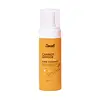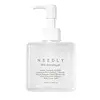What's inside
What's inside
 Key Ingredients
Key Ingredients

 Benefits
Benefits

 Concerns
Concerns

 Ingredients Side-by-side
Ingredients Side-by-side

Water
Skin ConditioningGlycerin
HumectantLauryl Glucoside
CleansingDisodium Cocoamphodiacetate
CleansingSodium Cocoyl Glutamate
CleansingButylene Glycol
HumectantSodium Chloride
MaskingPentylene Glycol
Skin ConditioningPolyglyceryl-10 Myristate
Skin ConditioningDaucus Carota Sativa Root Extract
Skin ConditioningDaucus Carota Sativa Extract
PerfumingZingiber Officinale Root Extract
MaskingCurcuma Longa Root Extract
MaskingSalicylic Acid
MaskingCoco-Glucoside
CleansingQuillaja Saponaria Bark Extract
CleansingLactobacillus Ferment
Skin ConditioningCamellia Sinensis Leaf Extract
AntimicrobialEnantia Chlorantha Bark Extract
Skin ConditioningOriganum Vulgare Leaf Extract
Skin ConditioningRosa Canina Fruit Extract
AstringentNymphaea Alba Flower Extract
Skin ConditioningOleanolic Acid
Skin ConditioningSodium Cocoyl Isethionate
Cleansing1,2-Hexanediol
Skin ConditioningPolyglyceryl-10 Laurate
Skin ConditioningSodium Phytate
Caprylic/Capric Triglyceride
MaskingDipropylene Glycol
HumectantSodium Palmitoyl Proline
Skin ConditioningWater, Glycerin, Lauryl Glucoside, Disodium Cocoamphodiacetate, Sodium Cocoyl Glutamate, Butylene Glycol, Sodium Chloride, Pentylene Glycol, Polyglyceryl-10 Myristate, Daucus Carota Sativa Root Extract, Daucus Carota Sativa Extract, Zingiber Officinale Root Extract, Curcuma Longa Root Extract, Salicylic Acid, Coco-Glucoside, Quillaja Saponaria Bark Extract, Lactobacillus Ferment, Camellia Sinensis Leaf Extract, Enantia Chlorantha Bark Extract, Origanum Vulgare Leaf Extract, Rosa Canina Fruit Extract, Nymphaea Alba Flower Extract, Oleanolic Acid, Sodium Cocoyl Isethionate, 1,2-Hexanediol, Polyglyceryl-10 Laurate, Sodium Phytate, Caprylic/Capric Triglyceride, Dipropylene Glycol, Sodium Palmitoyl Proline
Water
Skin ConditioningPotassium Laureth Phosphate
EmulsifyingGlycerin
HumectantButylene Glycol
HumectantPotassium Cocoyl Glutamate
Acrylates/C10-30 Alkyl Acrylate Crosspolymer
Emulsion Stabilising1,2-Hexanediol
Skin ConditioningCaprylyl Glycol
EmollientSodium Cocoyl Glutamate
CleansingSalicylic Acid
MaskingCoco-Glucoside
CleansingPolyglyceryl-10 Laurate
Skin ConditioningSodium Cocoyl Isethionate
CleansingParfum
MaskingSodium Phytate
Quillaja Saponaria Bark Extract
CleansingCitric Acid
BufferingSodium Citrate
BufferingWater, Potassium Laureth Phosphate, Glycerin, Butylene Glycol, Potassium Cocoyl Glutamate, Acrylates/C10-30 Alkyl Acrylate Crosspolymer, 1,2-Hexanediol, Caprylyl Glycol, Sodium Cocoyl Glutamate, Salicylic Acid, Coco-Glucoside, Polyglyceryl-10 Laurate, Sodium Cocoyl Isethionate, Parfum, Sodium Phytate, Quillaja Saponaria Bark Extract, Citric Acid, Sodium Citrate
Ingredients Explained
These ingredients are found in both products.
Ingredients higher up in an ingredient list are typically present in a larger amount.
1,2-Hexanediol is a synthetic liquid and another multi-functional powerhouse.
It is a:
- Humectant, drawing moisture into the skin
- Emollient, helping to soften skin
- Solvent, dispersing and stabilizing formulas
- Preservative booster, enhancing the antimicrobial activity of other preservatives
Butylene Glycol (or BG) is used within cosmetic products for a few different reasons:
Overall, Butylene Glycol is a safe and well-rounded ingredient that works well with other ingredients.
Though this ingredient works well with most skin types, some people with sensitive skin may experience a reaction such as allergic rashes, closed comedones, or itchiness.
Learn more about Butylene GlycolCoco-Glucoside is a surfactant, or a cleansing ingredient. It is made from glucose and coconut oil.
Surfactants help gather dirt, oil, and other pollutants from your skin to be rinsed away.
This ingredient is considered gentle and non-comedogenic. However, it may still be irritating for some.
Learn more about Coco-GlucosideGlycerin is already naturally found in your skin. It helps moisturize and protect your skin.
A study from 2016 found glycerin to be more effective as a humectant than AHAs and hyaluronic acid.
As a humectant, it helps the skin stay hydrated by pulling moisture to your skin. The low molecular weight of glycerin allows it to pull moisture into the deeper layers of your skin.
Hydrated skin improves your skin barrier; Your skin barrier helps protect against irritants and bacteria.
Glycerin has also been found to have antimicrobial and antiviral properties. Due to these properties, glycerin is often used in wound and burn treatments.
In cosmetics, glycerin is usually derived from plants such as soybean or palm. However, it can also be sourced from animals, such as tallow or animal fat.
This ingredient is organic, colorless, odorless, and non-toxic.
Glycerin is the name for this ingredient in American English. British English uses Glycerol/Glycerine.
Learn more about GlycerinPolyglyceryl-10 Laurate is an ester of lauric acid and Polyglycerin-10.
Polyglyceryl-10 Laurate is a cleansing agent and emulsifier. It helps gather dirt, oil, and other pollutants to be rinsed away. As an emulsifier, it helps prevent ingredients from separating, such as oil and water.
Polyglyceryl-10 Laurate may not be fungal acne safe.
Learn more about Polyglyceryl-10 LaurateWe don't have a description for Quillaja Saponaria Bark Extract yet.
Salicylic Acid (also known as beta hydroxy acid or BHA) is a well-known ingredient for treating skin that struggles with acne and clogged pores. It exfoliates both the skin's surface and deep within the pores to help clear out buildup, control oil, and reduce inflammation.
Unlike AHAs (alpha hydroxy acids), salicylic acid is oil-soluble. This allows it to penetrate into pores which makes it especially effective for treating blackheads and preventing future breakouts.
Salicylic acid is also known for its soothing properties. It has a similar structure to aspirin and can calm inflamed or irritated skin, making it a good option for acne-prone skin that is also sensitive.
Concentrations of 0.5-2% are recognized by the U.S. FDA as an over-the-counter topical acne product.
It can cause irritation and/or dryness if one's skin already has a compromised moisture barrier, so it's best to focus on repairing that before introducing this ingredient into your routine.
While salicylic acid does not increase sun sensitivity, it’s still important to wear sunscreen daily to protect your skin.
If you are looking for the ingredient called BHA or Butylated Hydroxyanisole, click here.
Learn more about Salicylic AcidSodium Cocoyl Glutamate is a gentle cleanser and surfactant. It is the sodium salt of the Cocoyl Glutamic Acid and comes from coconut oil. As a surfactant, it helps lift dirt and oil to be washed away.
Sodium Cocoyl Glutamate also has an emolliating effect and can help leave the skin feeling soft.
Sodium cocoyl isethionate is a natural ingredient from coconut oil. It is an ultra gentle cleanser that gives a nice foam without drying the skin or impacting the skin barrier.
The amount of foam created depends on the amount of sodium cocoyl isethionate used in the product.
This ingredient also helps improve the spreadability of a product.
Learn more about Sodium Cocoyl IsethionateSodium Phytate is the synthetic salt form of phytic acid. Phytic acid is an antioxidant and can be found in plant seeds.
Sodium Phytate is a chelating agent. Chelating agents help prevent metals from binding to water. This helps stabilize the ingredients and the product.
Water. It's the most common cosmetic ingredient of all. You'll usually see it at the top of ingredient lists, meaning that it makes up the largest part of the product.
So why is it so popular? Water most often acts as a solvent - this means that it helps dissolve other ingredients into the formulation.
You'll also recognize water as that liquid we all need to stay alive. If you see this, drink a glass of water. Stay hydrated!
Learn more about Water